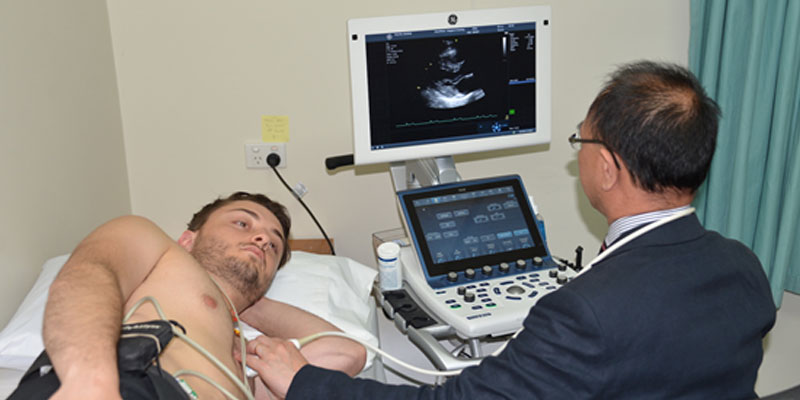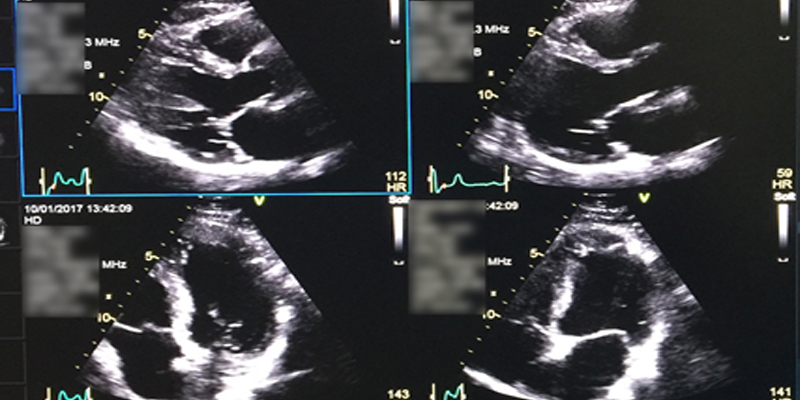Stress Echocardiogram
Stress Echocardiogram (Stress Echo) is a test to assess heart function under physical stress. It uses ultrasound waves (inaudible sound waves) to image the heart and assess its function before and immediately after the exercise to see how the heart muscle pump is working, and sometimes to measure other parameters.
Why is it done?
This test is done is to see if there is reduced blood supply to any portion of the heart which may mean that there may be a narrowing/ blockage in one of the coronary arteries supplying blood to that part of the heart muscle.
There are also other reasons where your doctor may request Stress Echo – for example to assess valve function under stress, measure pressure changes in the heart during stress and sometimes for licensing and other purposes. There are a whole range of reasons why this test is done.
Before the test

Usually there are few instructions given before the test, for example which medications to take and which to with hold for the test. If you haven’t been given such instructions please check with your referring doctor. You don’t need to fast but it’s a good idea not to have a big meal before the test. As you will be exercising, light loose, comfortable clothing and walking shoes are preferable. Dress up so that the top is separate and can be easily removed.

How the Test is Performed
The technologist will place ECG electrodes on your chest and back after rubbing skin with a light.
abrasive material and alcohol swab. In men with a lot of hair, they may need to be shaved off.

Your ECG electrodes will be connected to the ECG monitor (seen as a continuous ECG graph on the computer screen) and then you will be asked to lie down on
the bed for the initial ultrasound imaging of the heart. These are called rest images.
While you lie on your left side with your left arm out, and right arm resting down, ultrasound probe (transducer) will be held against your chest in various areas. A special gel is used to help the ultrasound waves get to your heart. This can be felt as cold when first applied to your warm skin.

Rest Images are taken briefly (perhaps 3 to 5 minutes) and then you will be asked to get up and start exercise either on a treadmill. This phase is called the stress phase. The treadmill starts very slow at a speed of 2.7 km/hr and an incline of 10 degrees. The treadmill will go faster and higher every few minutes depending on the protocol being used. The idea is to get your heart rate faster to its maximum which is determined by age and fitness level. Most people can exercise between 5 to 12 minutes.(perhaps 3 to 5 minutes) and then you will be asked to get up and start exercise either on a treadmill This phase is called the stress phase.

Your ECG will be monitored throughout the procedure.
The treadmill is stopped when you tell the staff to stop due to any reason (either you are fatigued and tired or you have chest pain or significant shortness of breath). The treadmill is also stopped by the doctor for other reasons. Please do not try to jump off the treadmill or press the stop button while exercising. Ask the team to stop the treadmill
The moment treadmill comes to a complete standstill, you will be asked to come off the treadmill and lie down in the bed taking the same position. At this juncture time is of utmost importance as stress images are needed to be taken as close to the peak exercise as possible. The doctor will be ready to scan your heart and take stress images with same ultrasound probe. This may take up to 60 seconds.
After the Test
After another few minutes the ECG monitor will be disconnected and ECG electrodes will be removed. You will be given tissue paper to clean up your sweat as well as the gel applied by the Echo Tech. At this stage a Cardiologist will have look at the images and will let you know about the result.
Most stress echo tests take about 20-30 minutes altogether
Feeling a little bit dizzy after the test is normal. Shortness of breath proportional to the exercise performed is also normal. However disproportional shortness of breath and any chest pain / discomfort or palpitations etc is abnormal and should be reported to the doctor present during the test. Any drop in blood pressure is also abnormal.
Result
- A normal test will most often mean that you were able to exercise as long as or longer than most people of your age and gender. You also did not have symptoms or concerning changes in blood pressure and/or your ECG. Your heart pictures show that all parts of your heart respond to increased stress by pumping harder. A normal result means that blood flow through the coronary arteries is probably normal.
• Abnormal result (called positive result) may be due to reduced blood flow to a part of the heart. The most likely cause is a narrowing or blockage of the artery supplying blood to that part of your heart muscle. There are a number of other reasons why the test might be positive, which are beyond the scope of this introduction.
